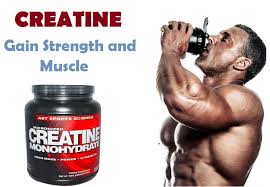
Creatine Build The Muscles
Creatine is one of the most popular supplements in the fitness industry. It is a naturally occurring combination of amino acids found in meat or fish or produced in the liver, kidneys, and pancreas. Creatine is a nitrogenous organic acid that occurs naturally in the vertebrates and helps the body supply energy to the cells in our body. This compound is formed of three amino acids: L-arginine, glycine and L-methionine and makes up about 1% of the total volume of human blood The body can build or synthesize creatine using amino acids from the plant or animal protein in foods we eat. According to Vegan Health and Men’s Health, creatine is one of few nutritional supplements scientifically proven to increase muscle mass and endurance on a consistent basis, provided that users participate in a regular weightlifting regimen.
Some people use creatine to help with illnesses such as Parkinson’s Disease, Congestive Heart Failure, Depression And Arthritis. Creatine is thought to improve strength, increase lean muscle mass, and help the muscles recover more quickly during exercising. This muscular boost may help athletes achieve bursts of speed and energy, especially during short bouts of high-intensity activities such as lifting weights or sprinting.
Benefits Of Creatine
- Increase in muscle size – Creatine supplementation causes an increase in the water content of muscles, making them “larger.” This is not due to an increase in the size of the muscle fibers. However, creatine can increase “real” fat free mass over time, as its strength and power-boosting properties allow higher quality training and thus, better gains.
- Improved athletic performance – A large body of research shows that oral creatine supplementation can make an athlete faster and stronger when performing high intensity activity.
Who Should Avoid Taking Creatine
- People With Diabetes
- People With Kidney Disease People On Blood Sugar Medication
Important Facts About Creatine
- Creatine is a nitrogenous organic acid comprised of three amino acids
- Athletes use creatine to assist in high-intensity training
- Creatine was first described in 1832
- Although creatine is produced naturally in the body, it can also be taken in through diet or supplements
- There is some evidence that creatine can boost memory
- Side effects can include stomach cramps and nausea.
Foods High In Creatine
Animal proteins
Especially those contained in beaf, salmon, and tuna. It is accounted that about one pound of beef consists of 5 grams of creatine monohydrate, and one pound of red meat contains 2 grams of creatine monohydrate.
Fish
There is about 4.5 grams in one pound of salmon. In addition, sea food items such as tuna, sushi, and sashimi are highly rich in creatine monohydrate.
Other Sources Of Creatine
As stated above, creatine is found in meat or fish and science says that there are no vegetarians sources. Therefore, vegetarians have to get enough of the amino acids arginine, glycine, and methionine which are used in production of creatine. Foods rich in arginine are peanuts, walnuts, coconuts, soybeans, chickpeas, and oats. Foods rich in glycine are raw seaweed or spirulina , raw watercress, spinach, soy protein isolate, and sesame seeds. Brazil nuts, oats, and sunflower seeds are great sources of methionine. It is important to note that vegetarians who get enough of these amino acids through diet still have less stored creatine than non-vegetarians.
